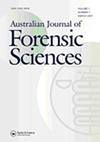Enhanced Matrix Removal-Lipid (EMR-L): a novel approach for efficient clean-up in systemic toxicological analysis of drugs and pesticides
IF 1.1
4区 医学
Q4 MEDICINE, LEGAL
引用次数: 0
Abstract
ABSTRACTThe QuEChERS extraction method was extensively modified and validated for effective screening of drugs and pesticides in diverse biological matrices, such as blood, urine, liver, and stomach contents. This method involved the extraction of 2 mL biological samples using acetonitrile as the solvent. To eliminate interferences, particularly lipids, a novel sorbent comprising a combination of C18 and specialized polymers called EMR-L (Enhanced Matrix Removal-Lipid) was employed. The extracted samples were then subjected to analysis using GCMS with a DB-5 MS column. The validation study encompassed various parameters including carryover, limit of detection (LOD), and interference investigation. LOD of analytes were ranged from 0.5 to 1.0 µg/mL. The validated method is known for its simplicity and effectiveness in conducting systemic toxicological analysis, covering a wide range of acidic, neutral, and basic analytes. Moreover, this method has the potential to detect additional drugs and pesticides not included in the validation study, provided they are compatible with gas chromatographic analysis. The modified method was successfully applied to real case samples, proving to be a valuable tool for systemic toxicological analysis. Its versatility allows for the screening of acidic, neutral, and basic drugs and pesticides in various biological matrices.KEYWORDS: QuEChERSEMRdrugspesticidespostmortemsystemic toxicologyunknown screen Disclosure statementNo potential conflict of interest was reported by the author(s).增强基质去除-脂质(EMR-L):一种在药物和农药系统毒理学分析中高效清除的新方法
摘要对QuEChERS提取方法进行了广泛的改进,并验证了该方法在血液、尿液、肝脏和胃内容物等不同生物基质中对药物和农药的有效筛选。该方法以乙腈为溶剂提取2ml生物样品。为了消除干扰,特别是脂类,采用了一种由C18和称为EMR-L(增强基质去除脂类)的特殊聚合物组成的新型吸附剂。提取的样品用DB-5质谱柱进行气相色谱分析。验证研究包括各种参数,包括携带,检出限(LOD)和干扰调查。LOD范围为0.5 ~ 1.0µg/mL。经过验证的方法以其简单和有效的系统毒理学分析而闻名,涵盖了广泛的酸性,中性和碱性分析物。此外,该方法具有检测验证研究中未包括的其他药物和农药的潜力,前提是它们与气相色谱分析兼容。改进后的方法已成功应用于实际病例样本,为系统毒理学分析提供了一种有价值的工具。它的多功能性允许在各种生物基质中筛选酸性,中性和碱性药物和农药。关键词:quecher semr药物农药死后系统毒理学未知筛选披露声明作者未报告潜在的利益冲突。
本文章由计算机程序翻译,如有差异,请以英文原文为准。
求助全文
约1分钟内获得全文
求助全文
来源期刊

Australian Journal of Forensic Sciences
MEDICINE, LEGAL-
CiteScore
3.20
自引率
10.00%
发文量
41
审稿时长
>12 weeks
期刊介绍:
The Australian Journal of Forensic Sciences is the official publication of the Australian Academy of Forensic Sciences and helps the Academy meet its Objects.
The Academy invites submission of review articles, research papers, commentaries, book reviews and correspondence relevant to Objects of the Academy. The Editorial policy is to attempt to represent the law, medicine and science and to promote active discussions of the relevant issues of the time as they affect the professional practice of the forensic sciences. The Journal is not restricted to contributions only from Australian authors but it will attempt to represent issues of particular relevance to Australia and its region.
The meetings of the Academy normally include a plenary presentation and the Journal will seek to publish these presentations where appropriate.
 求助内容:
求助内容: 应助结果提醒方式:
应助结果提醒方式:


